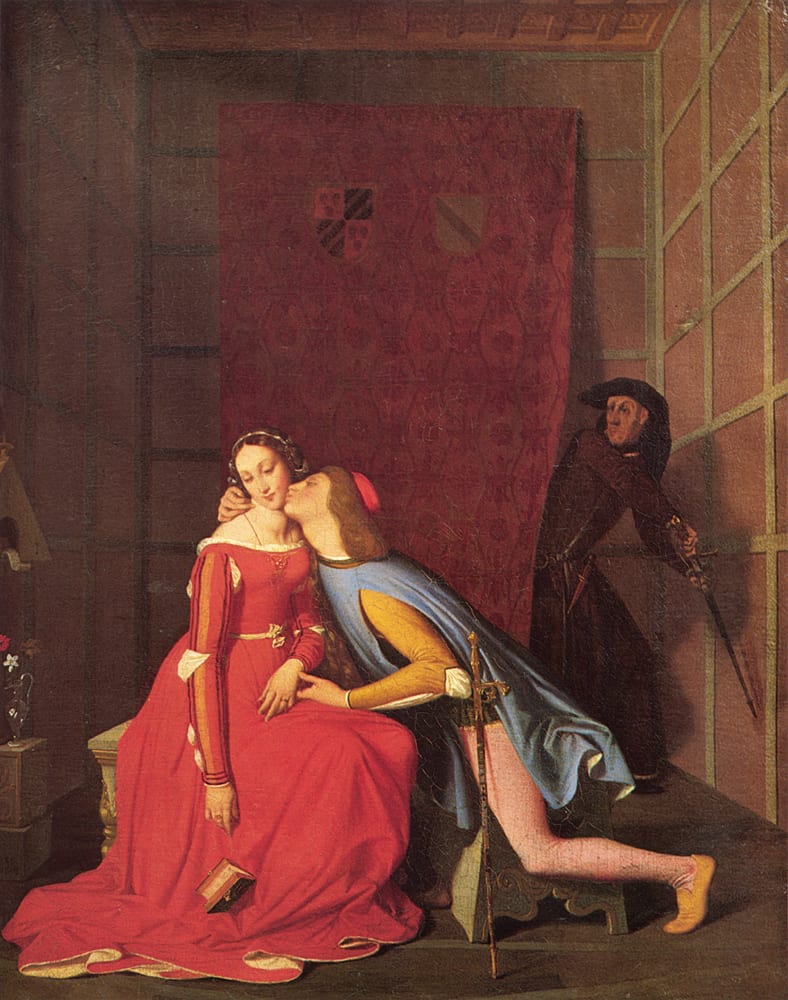Paolo and Francesca: Words of Desire. Introduction to Inferno 5
View more in A Hell of a City: Dante’s Inferno on the Road to Rome | Paolo and Francesca: Words of Desire (Inferno 5)

Having left behind the dark wood (cantos 1-2), passed through the gate and the vestibule of Hell where the uncommitted run in circles, crossed the Acheron river on Charon’s boat (canto 3), and visited the Limbo located in the first circle of Hell where the souls of those who didn’t receive baptism dwell, including the great poets and philosophers of antiquity (canto 4), Dante-pilgrim and his guide, the poet Virgil, reach the second circle of Hell.
Here, lust is punished, the first of the sins of incontinence, that can be defined as an irrational lack of control over an excess of wrongly directed love and bodily appetites for ephemeral goods. Incontinence characterizes also the following three circles where gluttony (third circle, guarded by Cerberus, canto 6), avarice, and prodigality (fourth circle, guarded by Plutus, canto 7), and anger and sullenness (fifth circle, cantos 7-8, punished in the river Styx that Dante and Virgil cross on Phlegyas’s boat) are respectively condemned in eternity. The structure of Hell will be described by Virgil in canto 11 and defined according to Aristotle’s “Nicomachean Ethics,” filtered through Thomism, a Medieval philosophy conceived by Dante’s contemporary St. Thomas Aquinas (1225-1274). Crime and punishment are in a relation of either analogy or opposition called contrappasso.
A deformed version of the classical figure of Minos, here represented as a beast with a long tail, presides over the passage into Hell proper. Minos is here as an infernal judge and assigns each sinner to their own eternal destination. In the second circle, the lustful who in life let passion and sexual desire overtake reason, are carried around by the hellish squall, a terrible storm that bellows in this ‘place mute of all light.’ Dante-pilgrim asks about a group of sinners, and Virgil points to several historical and literary characters whose stories had been told by some of the most important historians and poets from antiquity. This is ‘the troop where Dido is,’ the queen of Carthage, loved and then abandoned by Aeneas whom she had welcomed and protected in her kingdom as Virgil recounts in the fourth book of his poem, the “Aeneid.” Dido commits suicide, and Aeneas will see her shade taking refuge in her husband’s shade in the Underworld in the Mourning Fields that the hero visits in the sixth book of the same poem.
What follows in canto 5 of Inferno, is Dante-poet’s own response to Virgil’s Dido and more comprehensively to medieval love literature founded on the idea of courtly love, an extramarital kind of love inspired by the nobility of knights and ladies and chivalric ideals of quest and service that had been celebrated in the literary cycle known as the Matter of Britain focused around King Arthur and the Knights of the Round Table in the kingdom of Camelot. Dante-pilgrim talks to Francesca, the damned soul of a contemporary woman, who is punished in the second circle with her silent lover and brother-in-law Paolo. The two had fallen in love reading one of the romances from the cycle of King Arthur, which tells the story of the love affair between Queen Guinevere, Arthur’s wife, and Arthur’s best knight, Lancelot. The various love stories alluded to and recounted in Dante’s canto 5 mirror each other, and the canto keeps refracting the same love theme over and over again in a climax that culminates with Dante-pilgrim fainting overwhelmed by pity for the two contemporary lovers.
Such is the deceitful and annihilating power of passion and of the literature inspired by that kind of love. One of the purposes of Dante the poet will be defining a new kind of love and establishing a new genre of love literature in the course of the journey of salvation and of the poem, leaving behind the old literary tradition once he has appropriated it and regenerated it in new contents and forms and in a new literary language, his own Florentine vernacular.
2 minutes
